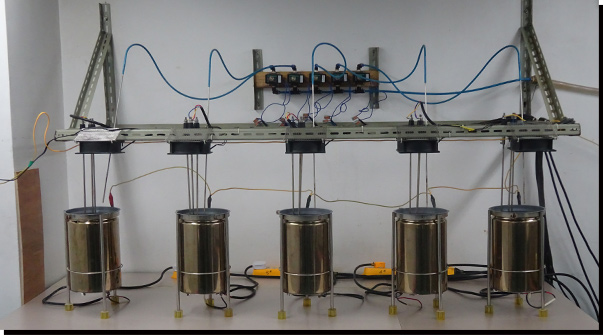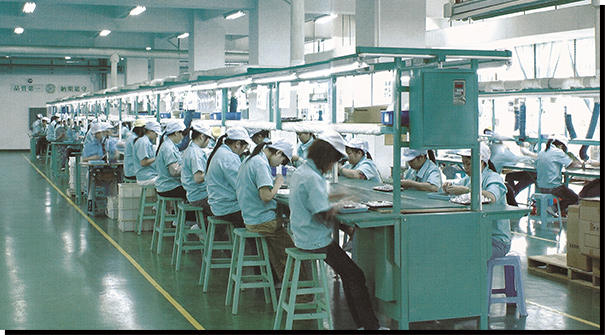-
01
Downsizing warm-air heaters

-
Background
Because multi-functioning is advancing in electric appliances, the number of parts is increasing and space for these parts is becoming smaller. -
Challenges
It is necessary to take on the challenge of meeting specifications that conventional designs cannot meet.
・ Miniaturization of parts
・ Securing insulation distance
・ Durability due to the high specifications of parts -
Solutions
• Selection of parts, improved design of structures and shapes.
• We collaborate with our customers to confirm quality through endurance tests. ⇒ We succeeded in enabling a level of downsizing that was not possible in the past.
-
-
02
Higher heater output

-
Background
Higher heater output and temperature are required according to the usage of electric appliances.
Example) Shorter boiling time for hot water dispensers, etc. -
Challenges
It is necessary to improve durability as temperature exposure rises. -
Solutions
• Elucidation of disconnection mechanism through reproduction tests.
• Improvement of thermal efficiency by reviewing the heater structure.
• Checking the efficacy of improvements for factors related to breaking wires.
• We could respond to requests from customers by checking durability in durability tests.
-
-
03
Energy saving in heaters
-
Background
Energy saving is a major challenge for home electric appliances in terms of the environmental aspect, thus, we have received an increasing number of requests from customers to focus on energy saving. -
Challenges
The challenge is in figuring out how heat generated from a heater may be transferred to the object to be heated. -
Solutions
• Thin heater (designed to ensure insulation performance that can only be realized by a mica maker).
• Limiting the direction of heating through structural changes.
• We contributed further to energy saving through our proposal for how to install heater (improved thermal efficiency) for customers.
-
-
04
Prompt manufacturing of prototypes

-
Background
Much time is needed to evaluate developed products because new products are released every year with advancing multiple functions in home electric appliances. Under these circumstances, it is fatal to take too long to procure prototypes. -
Challenges
• Accuracy of design – Design with consideration of usage conditions.
• Speedy shipment – At the early phase of design, customers would like to get requested samples as soon as possible.
-
Solutions
• We may design with high accuracy to meet customers’ requests by asking customers to disclose the necessary information for heater design, including usages, environments, or situations, in addition to basic characteristics such as voltage, output, size, etc.
• We select parts based on a huge amount of data collected across the past 30 years and design products safely at an affordable price.
• In-house processing with equipment such as a laser processing machine, enables quick delivery of trial production. ⇒ Contributes to reducing the number of prototypes and shortened development periods.
• We have a trial record of 30 years, and we have some sample materials, so we can respond to trial production early.
• We can handle time-consuming tasks such as the procurement of special materials or a small amount of parts samples, etc.
-
-
05
Schedule management
-
Background
We often hear customers say "The launch of the mass production schedule will be tight!"
"Even if the evaluation is completed as planned, the specifications are established, and the mass production stage is reached, product assembly will not be completed on time!" Have you experienced something like that? -
Challenges
• Many designers do not always understand the lead time for procurement of various parts.
• It takes time to check the reliability of parts and understand costs.
• It takes time to solve challenges during product assembly.
-
Solutions
• We have a consensus about customer’s schedules (a targeted launch date, arrangement of parts, determination of specifications, prototypes for mass production, DR, etc.) from the development phase so that we can meet the customer’s requested schedule. We can have in-depth meetings and make proposals from the development phase.
• We monitor the progress of each process based on the schedule management plan. ⇒We have achieved a smooth mass production start-up from material procurement to trial production.
• We can support evaluation tests that take time and effort.
• We can deliver products to specified plants smoothly by the lead time management from subcontract plants to logistics and thorough stock management.
-
-
06
Maintaining high quality and procurement of parts

-
Background
For the purpose of cost reduction, customers and each part manufacturer have moved their production plants overseas. However, although quality has been improved than before, many customers may not yet be satisfied with the present quality in reality. -
Features of our company
• We have subcontract plants in China (Shenzhen).
• With ISO9001, we maintain high quality using the same quality control system and production system as those in Japan.
• The subcontracting factories also have parts procurement departments, so it is possible to procure overseas manufactured parts.
• Our staff in Japan perform safety checking, specification checking, and safety assessments of our overseas manufactured parts.
• Our Japanese staff have a role to play in maintaining quality for the overseas outsourcing management.
-
-
07
Embedded heater

-
Background
We guess many customers may struggle to meet requests for a highly-accurate heater with a small range of temperature tolerance.
(Example) Heater for semiconductor manufacturing equipment -
Challenges
• Because there are many holes for installation and there is less design freedom for a winding wire type mica plane heater, we cannot solve thermal nonuniformities.
-
Solutions
• We propose an embedded type mica heater of which element patterns can freely be placed in the arrangeable area of heating elements.
• If output distribution is provided, we can design element patterns by ourselves.
• Using the technology that can be provided as a mica manufacturer, we process mica and element patterns for integration.
⇒ Through integration, thermal nonuniformities caused by variations in heating plate installation can be reduced. The handling of products has become easier.
-
-
What’s Mica?
-
Knowing how mica is used through illustrations
-
Okabe Mica in numbers
-
Industry-specific PR
-
Development Examples
-
Original Technology
-
Customer reviews
-
Product Information
-
Corporate Information
-
What's New
EN/JP
